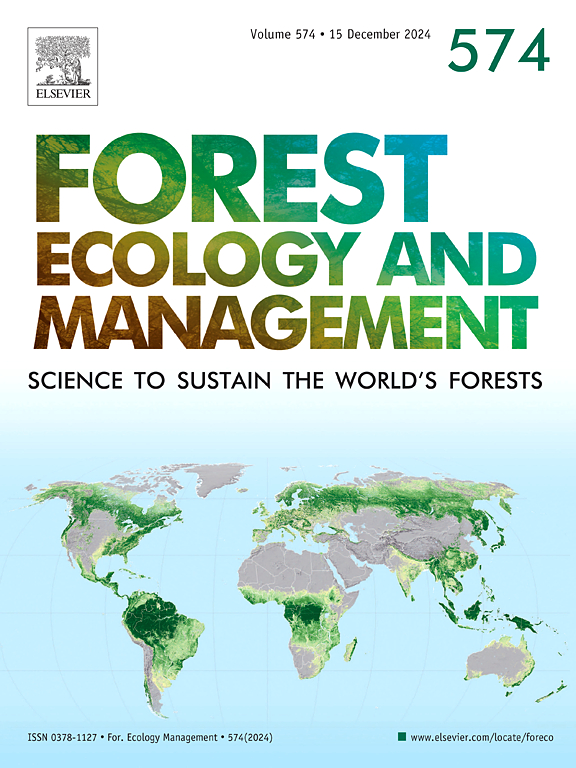Effects of a three-year warming on the growth and nutritional status of the young generation of silver fir (Abies alba Mill.) in the Western Carpathians
IF 3.7
2区 农林科学
Q1 FORESTRY
引用次数: 0
Abstract
Climate warming significantly affects forest ecosystems, altering site conditions and threatening main forest-forming species. Norway spruce (Picea abies (L.) H.Karst) stands in the Central Europe are declining due to climate change, necessitating alternative silvicultural strategies. Silver fir (Abies alba Mill.), shade-tolerant species with the potential to form multi-storey stands, has been proposed as a potential replacement. However, its response to warming in spruce-dominated stands remains unclear. This study presents results from a three-year in situ climate experiment in the Western Carpathians, where soil warming of 0.5 °C simulated future climate conditions. Dendroclimatic and biogeochemical approaches were used to assess the effects of warming on the growth and nutrient status of young silver fir trees, growing as a young generation in a decaying spruce stand. Results indicate that while initial height and diameter growth were not significantly affected by warming, a declining growth trend emerged after three years, suggesting that temperature conditions exceeded the species' optimal range. Furthermore, warming reduced main macro- and micronutrient concentrations in fir needles, especially calcium (Ca), phosphorus (P), potassium (K), magnesium (Mg), copper (Cu) and manganese (Mn), which are essential for physiological processes and stress resistance. Stoichiometric analyses revealed shifts in carbon (C), nitrogen (N) and P ratios, indicating possible nutrient imbalances. The results highlight the vulnerability of young fir trees to warming and suggest that future forest adaptation strategies must consider both physiological responses and site conditions. Long-term studies are needed to determine the sustainability of silver fir as a replacement species in mountain ecosystems.
三年的变暖对西部喀尔巴阡山脉年轻一代银杉(冷杉)生长和营养状况的影响
气候变暖严重影响了森林生态系统,改变了立地条件并威胁到主要的森林形成物种。挪威云杉(Picea abies, L.)由于气候变化,中欧的喀斯特林分正在减少,因此需要其他造林策略。银杉(Abies alba Mill.)是一种耐阴的树种,具有形成多层林分的潜力,已被提议作为潜在的替代品。然而,它对以云杉为主的林分变暖的反应尚不清楚。本研究介绍了在西喀尔巴阡山脉进行的为期三年的原位气候实验的结果,在那里土壤变暖0.5°C模拟了未来的气候条件。采用树木气候学和生物地球化学方法,评估了变暖对在凋落云杉林分中生长的年轻一代银杉幼树生长和营养状况的影响。结果表明,增温对柽柳株高和株径的生长影响不显著,但3年后出现了下降趋势,表明增温超出了柽柳的最佳生长范围。此外,增温降低了冷杉针叶中主要宏、微量元素浓度,尤其是钙(Ca)、磷(P)、钾(K)、镁(Mg)、铜(Cu)和锰(Mn),这些元素对生理过程和抗逆性至关重要。化学计量分析揭示了碳(C)、氮(N)和磷比率的变化,表明可能存在营养失衡。研究结果强调了冷杉幼树对变暖的脆弱性,并建议未来的森林适应策略必须同时考虑生理反应和立地条件。需要长期研究来确定银杉作为山地生态系统替代树种的可持续性。
本文章由计算机程序翻译,如有差异,请以英文原文为准。
求助全文
约1分钟内获得全文
求助全文
来源期刊

Forest Ecology and Management
农林科学-林学
CiteScore
7.50
自引率
10.80%
发文量
665
审稿时长
39 days
期刊介绍:
Forest Ecology and Management publishes scientific articles linking forest ecology with forest management, focusing on the application of biological, ecological and social knowledge to the management and conservation of plantations and natural forests. The scope of the journal includes all forest ecosystems of the world.
A peer-review process ensures the quality and international interest of the manuscripts accepted for publication. The journal encourages communication between scientists in disparate fields who share a common interest in ecology and forest management, bridging the gap between research workers and forest managers.
We encourage submission of papers that will have the strongest interest and value to the Journal''s international readership. Some key features of papers with strong interest include:
1. Clear connections between the ecology and management of forests;
2. Novel ideas or approaches to important challenges in forest ecology and management;
3. Studies that address a population of interest beyond the scale of single research sites, Three key points in the design of forest experiments, Forest Ecology and Management 255 (2008) 2022-2023);
4. Review Articles on timely, important topics. Authors are welcome to contact one of the editors to discuss the suitability of a potential review manuscript.
The Journal encourages proposals for special issues examining important areas of forest ecology and management. Potential guest editors should contact any of the Editors to begin discussions about topics, potential papers, and other details.
 求助内容:
求助内容: 应助结果提醒方式:
应助结果提醒方式:


